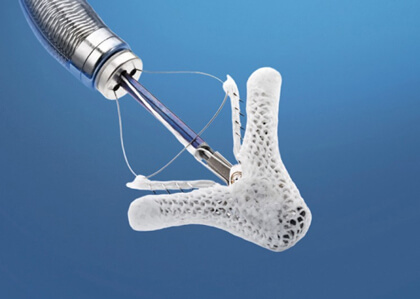Courtesy of Dr. Carlos Fava.
The fact that the outcomes of edge-to-edge repair with MitraClip have improved, particularly in the immediate and short term, is widely known. Such improvement is basically a result of more operator experience and the arrival of 3-D echocardiography. However, there are no mid-term follow-up studies available, except for the EVEREST trial, which had a 5-year follow-up during the early years of the aforementioned strategy.

This study analyzed 339 patients who received MitraClip. The cause for mitral regurgitation was functional (FMR) in 242 cases and degenerative (DMR) in the remaining 97.
Groups were similar, but patients with DMR were older, there were more women among them, patients had less coronary disease, lower Pro BNP, higher ejection fraction (57% vs. 27%, p < 0.001), and lower ventricular volumes and diameters.
Most patients in both groups received more than one clip. Implantation success (mitral regurgitation [MR] ≤2+) was around 95% and the residual valve area was 2.6 cm2.
Read also: Should We Start Using the Retrograte Access in Critical Limb Ischemia?
After 5 years of follow-up, the rate of survival was 53.5% for FMR patients and 57.1% DMR patients (p = 0.18). Survival was reduced by left ventricle remodeling in the FMR group and New York Heart Association functional class worsening in the DMR group. The functional class overall improved in both groups and there were no differences regarding the presence of MR ≥3 (23.7% vs. 27.9%).
Conclusion
In this single-center real-world experience, the 5-year progress of patients with severe mitral regurgitation who received MitraClip showed that over half of them survived. About 3 out of 4 patients were free from mitral regurgitation ¾+, both in FMR and DMR. Symptom improvement was sustained over time. Advanced ventricular remodeling, symptom progression, and suboptimal MR reduction were associated with worse outcomes. Improved patient selection, increased efficacy, and more information available will be necessary requirements for the improvement of long-term results.
Courtesy of Dr. Carlos Fava.
Original title:: Mid-term outcomes (up to 5 years) of percutaneous edge-to-edge mitral repair in the real-world according to regurgitation mechanism: A single-center experience.
Reference: Nicola Buzzatti, et al. Catheter Cardiovasc Interv. 2018;1–9.
Subscribe to our weekly newsletter
Get the latest scientific articles on interventional cardiology
We are interested in your opinion. Please, leave your comments, thoughts, questions, etc., below. They will be most welcome.




